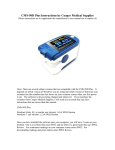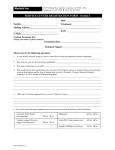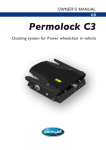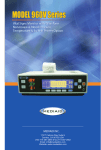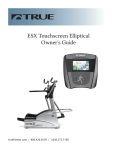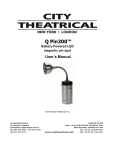Download Model 5300 Series POX Manual - English: Low Resolution
Transcript
Model 5300 Series Pulse Oximeter User’s Manual Model 5305 & Model 5340 MEDIAID INC. 17517 Fabrica Way • Cerritos California 90703 USA Tel.: 714-367-2848 • Fax: 714-367-2852 Web: www.mediaidinc.com Email: [email protected] Model 5300 Series Pulse Oximeters User’s Manual Model 5305 & Model 5340 0197 EU Authorized Representative (MDD 93/42/EEC) Mayer Engineering & Consulting Support GmbH Anna-Schieber-Weg2, D-73728 Esslingen, Germany F-9615 Rev 0 Table Of Contents Contents Chapter 1:Principles of Operation of the 5300 Series Pulse Oximeters ..................................................................................................... 1 1.1 Intended Uses ................................................................................................ 1 1.2 Principal Features .......................................................................................... 1 1.3 Modes Of Monitoring ..................................................................................... 2 1.4 Cautions ......................................................................................................... 2 Chapter 2: Keys, Indicators, Symbols and Markings ........................... 5 2.1 Keys and Indicators ....................................................................................... 5 2.2 Additional Features ........................................................................................ 9 2.3 Symbols and Markings ................................................................................10 Chapter 3: Operating the Model 5300 Series .......................................13 3.1 Receiving Accurate Readings .....................................................................13 3.2 Power............................................................................................................14 3.3 Measuring and Displaying Pulse Oximetry.................................................14 3.4 Data Transmission .......................................................................................16 3.5 Tests .............................................................................................................17 3.6 Cleaning Instructions ...................................................................................23 3.7 Troubleshooting ...........................................................................................23 Chapter 4: Equipment Specifications....................................................25 4.1 Oxygen Saturation And Pulse Rate ............................................................25 4.2 Alarms...........................................................................................................25 4.3 General .........................................................................................................25 4.4 Sensors ........................................................................................................26 4.5 Power Source...............................................................................................26 4.6 Environmental ..............................................................................................26 4.7 Equipment Classification .............................................................................26 Chapter 5: Order Information..................................................................29 5.1 Product Information .....................................................................................29 5.2 Contact Information .....................................................................................29 Chapter 6: Mediaid Inc Limited Warranty Information .......................31 6.1 Applicabilty of Warranty...............................................................................31 6.2 What Is Covered By This Warranty ............................................................31 6.3 What Mediaid Inc. Will Do To Correct Problems........................................31 6.4 Owner’s Registration ...................................................................................32 6.5 Product Information .....................................................................................33 Conformity..................................................................................................35 Declaration of Conformity ..................................................................................35 - Contents 1 - Principles of Operation Chapter 1: Principles of Operation of the 5300 Series Pulse Oximeters 1.1 Intended Uses •The Model 5305 is intended for spot checks. •The Model 5340 is intended for continuous monitoring. 1.2 Principle Features NOTE Before using the pulse oximeter, the user should become thoroughly familiar with the information in this manual and with all information included with the sensor. Models 5305 and 5340 •The Mediaid Inc. Model 5300 Series pulse oximeters are portable, WARNING lightweight instruments designed to monitor arterial oxygen saturation Do not use the pulse non-invasively. oximeter as an infant •Both models have two bright Light apnea alarm. Emitting Diode (LED) displays that give a constant read-out of oxygen saturation (in %SpO2) and heart rate in beats-per-minute (BPM). •Each machine has a front-panel LOW BATTERY INDICATOR that alerts the user to a low-battery condition. •Both models perform a functional test at power-on, and diagnostics tests can be initiated. •All MEDIAID INC. pulse oximetry sensors with RJ12 connectors are compatible with the Model 5300 Series. •Both pulse oximeters can be powered either by standard electric power or an internal, rechargeable Nickel-Cadmium (NiCad) battery. Model 5340 •The Model 5340 allows for data transmission through the DATA PORT (when Serial or Analog Cable is plugged in at power-up), while heart rate and -1- Principles of Operation %SpO2 are displayed on the OXYGEN SATURATION and PULSE RATE DISPLAYS. •The Model 5340 has visual and audible alarms for oxygen saturation and pulse rate monitoring. •The Model 5340 has an audible tone that sounds with each pulse and varies with oxygen saturation — falling in pitch with reduced saturation and rising as saturation increases. 1.3 Modes of Monitoring Models 5305 and 5340 •Both models in the Mediaid Inc. 5300 Series are designed to measure the oxygen saturation (%SpO2) of functional hemoglobin. •A normal (steady) display indicates the pulse oximeter has received at least three normal, intelligible pulses during the last 30-second period. The display will be updated each time a normal pulse has been received. A blinking display indicates the continuous presence (30 seconds or more) of significant patient movement or light-source interference. In this mode, no normal pulses are being received, and the last reliable values for %SpO2 and heart rate are displayed. Monitoring of %SpO2 may be adversely affected. Model 5340 •A blinking display with a one-second warning tone every 10 seconds indicates the continuous presence (60 seconds or more) of significant patient movement or light-source interference. In this mode, no normal pulses are being received and %SpO2 monitoring may be adversely affected. 1.4. Cautions •Before using the equipment, the operator should be thoroughly familiar with the information in the User’s Manual and all accompanying documents. •Federal (U.S.A.) law restricts this device to use by — or on the order of — a physician. •The instrument should not be used in the presence of anesthetics or flammable agents. •Do not allow any liquid to penetrate the instrument’s interior. •The Model 5300 Series Pulse Oximeters are designed to operate in normal, ambient light conditions. •Do not use near Magnetic Resonance Imaging equipment. •To avoid potential effects of electromagnetic interference, maintain a distance of -2- Principles of Operation at least 15 cm. (6") between the oximeter and other devices. Also, maintain a distance of at least 20 cm. (8") between the Mediaid Inc. wall adaptor and other devices. •When used with other equipment, such as a defibrillator, the accuracy of pulse oximetry readings may be affected. •In case of abnormal conditions during instrument operation, appropriate measures (such as powering off instruments) should be taken to insure patient safety. •The user should NOT attempt to modify or repair the instrument. •This device complies with Electromagnetic Compatibility standards EN55011 and EN60601-1-2. If the user experiences interference problems, move the unit away from other electromagnetic emitting equipment. •Dispose of this device according to hospital and/or governmental regulations. -3- Principe d’Utilisation -4- Keys, Indicators, Symbols and Markings Chapter 2: Keys, Indicators, Symbols and Markings 2.1 Keys and Indicators -5- Keys, Indicators, Symbols and Markings A. Power On/Off Key The unit is powered on with a short depression of the POWER ON/OFF KEY. A one-second display and indicator test is performed automatically, and all Light Emitting Diodes (LEDs) are illuminated. Carefully observe the OXYGEN SATURATION and PULSE RATE DISPLAYS at the top of the oximeter for proper operation of all segments of the display; a nonfunctioning segment will result in an incomplete numeral and possible erroneous reading. A long depression of the POWER ON/OFF KEY will initiate Internal Confidence and Self Diagnostics tests (see section 3.5 “Tests”). B. Pulse Rate Display Whenever the pulse oximeter receives at least three pulses during a 30-second period, the right, three-digit LED display shows the patient’s heart rate in beatsper-minute. Any blinking display signals that pulse rate monitoring may be adversely affected, and indicates the continuous presence (30 seconds or more) of significant patient movement or light-source interference. C. Oxygen Saturation Display Whenever the pulse oximeter receives at least three pulses during a 30-second period, the left LED display shows the patient’s %SpO2 levels. The display is updated with every normal pulse. A blinking display signals that %SpO2 monitoring may be adversely affected, and indicates the continuous presence (30 seconds or more) of significant patient movement or light-source interference. D. Visual Pulse Indicator As soon as a pulse is found, the heartbeat is indicated by the small green LED beneath the LED display window. The VISUAL PULSE INDICATOR simultaneously flashes with the patient’s pulse. It will typically begin to flash a few seconds before numerical values for oxygen saturation and pulse rate are shown. E. Low Battery Indicator The LOW BATTERY INDICATOR will illuminate when the battery is near depletion, prompting the user to suspend operation of the unit and change or recharge the battery (using the method described in Section 3.2 “Power”). The Pulse oximeter will -6- Keys, Indicators, Symbols and Markings automatically power off shortly after low-battery indication. The acronym bAt LO will be displayed if power-on is attempted during a low-battery condition. F. Sensor Cable Connection All Mediaid Inc. pulse oximetry sensors with RJ12 connectors are compatible with the Model 5300 Series. To connect a sensor to the pulse oximeter, align the plug with the jack on the oximeter and insert it gently until an audible “click” is heard — indicating that the plug tab is latched in place. To remove, squeeze the locking tab on the plug and slide the plug out of the jack. Always route cords in such a way as to prevent accidental tripping and subsequent damage to the oximeter. G. Power Connection For electric power, plug the adaptor into the pulse oximeter’s POWER CONNECTION, and then plug the other end of the adaptor into a standard electrical outlet. All Mediaid Inc. pulse oximeters were designed to be used with the adaptor provided by Mediaid Inc. at the time of purchase. H. Power Indicator The green LED — located on the bottom of the oximeter adjacent to the POWER CONNECTION — will illuminate when electric power is connected. I. Data Port Model 5340 The DATA PORT is used for serial and analog output. To eliminate risk of shock, do not touch the DATA PORT 8-pin connector and the patient simultaneously. The DATA PORT should be used only for connection to equipment that complies with CSA/IEC/UL601-1. Refer to section 3.4 for information on data transmission. J. Alarm Off Key Model 5340 A short depression of the ALARM OFF KEY silences the alarm for a period of 60 seconds. A long, three-second depression of the ALARM OFF KEY will completely disable the audible alarm. -7- Keys, Indicators, Symbols and Markings The LED display will show AL OFF, the ALARM OFF INDICATOR will begin to flash, and the oximeter will revert to normal monitoring. Silenced alarms can be reactivated by a short depression of the ALARM OFF KEY. Disabled alarms are reactivated by a long depression of the ALARM OFF KEY. K. Alarm Off Indicator Model 5340 The ALARM OFF INDICATOR will illuminate and remain on constantly when audible alarms are silenced, and will flash when audible alarms are disabled. NOTE Visual alarm indicators cannot be deactivated. L. Oxygen Saturation Alarm Key Model 5340 Short depressions of the OXYGEN SATURATION ALARM KEY will switch the display between the high and low alarm settings, as shown by the HI/LO ALARM INDICATORS. These alarm settings can be adjusted with the INCREMENT and DECREMENT KEYS. The alarm settings will be retained in memory until reset by the user. Exception: When the low-saturation alarm is set below 80%, it will return to 80% at the next power-up. The saturation alarm factory settings are: High 100% and Low 85%. The high-saturation alarm can be disabled by setting it at 100%. The unit reverts to normal monitoring after a five-second period of key inactivity. M. Pulse Rate Alarm Key Model 5340 Short depressions of the PULSE RATE ALARM KEY will switch the display between the high and low alarm settings as shown by the HI/LO ALARM INDICATORS. These alarm settings can be adjusted with the INCREMENT and DECREMENT KEYS. The alarm settings will be retained in memory until reset by the user. The pulse-rate alarm factory settings are: High 140 BPM and Low 50 BPM. The unit reverts to normal monitoring after a fivesecond period of key inactivity. -8- Keys, Indicators, Symbols and Markings N. Indrement & Decrement Keys Model 5340 The pulse-tone volumes can be adjusted using the INCREMENT and DECREMENT KEYS. There are three levels of audible (pulse) tone volume, and “off.” The pulse tone volume can be increased with the INCREMENT KEY, and decreased or silenced with the DECREMENT KEY. Alarm settings are also adjusted with these keys. O. Visual Hi/Lo Alarm Indicators HI LO Model 5340 Located beneath the OXYGEN SATURATION ALARM and PULSE RATE ALARM KEYS, these indicators illuminate when the patient’s oxygen saturation or pulse rate reaches the preset high or low alarm settings. In order to set alarms, the appropriate indicator must be illuminated. 2.2 Additional Features Audible Oxygen Saturatio Indicator Model 5340 A varying pitch of the audible tone signals a change in the %SpO2 level - a falling pitch indicates a decreasing %SpO 2 level. Audible Pulse Rate Indicator Model 5340 A beeping audible tone signals the heart beat. Audible Alarm Indicator Model 5340 The alarm tone is a fixed pitch, and the volume cannot be adjusted. Alarm conditions are generated only when a pulse has been detected. Alarm tones are automatically silenced when the alarm condition goes away. HIGH PRIORITY alarm tones sound continuously at the highest frequency and highest volume. HIGH PRIORITY alarms are caused by conditions such as: low and high oxygen saturation and pulse rate; no pulse; excessive ambient light; and other error conditions. MEDIUM PRIORITY alarm tones sound for 0.75 seconds every five -9- Keys, Indicators, Symbols and Markings seconds at the highest frequency and highest volume. MEDIUM PRIORITY alarms are cause by measuring problems such as disconnected sensor, too thin or thick tissue, or a faulty sensor. LOW PRIORITY alarm tones sound for one second every 10 seconds at the lowest frequency and highest volume. LOW PRIORITY alarms are caused by excessive patient movement or patient arrhythmia. 2.3 Symbols & Markings Symbol Definition SpO2 Oxygen Saturation Display BPM Pulse Rate Display Power On/Off Key Alarm Off KEY Oxygen Saturation Alarm KEY Pulse Rate Alarm KEY Increment Key Decrement Key - 10 - Keys, Indicators, Symbols and Markings Data Port Sensor Cable Connection Power Connection Low Battery Indicator Attention: Consult Accompanying Documents Non-anesthetic Proof Type BF Applied Part HI LO HI/LO Alarm Indicator - 11 - Principe d’Utilisation - 12 - Operating the Model 5300 Series Chapter 3: Operating the Model 5300 Series 3.1 Receiving Accurate Readings To prevent faulty readings and sensor complications: •Do not apply the sensor to anything but a well-perfused extremity. WARNING •Do not place the sensor on extremities To ensure personal safety with blood pressure cuffs or with and proper operation of arterial or venous catheters. the oximeter, the user •Avoid extremity positions that may compress venous return. should adhere to all •Keep sensors at heart level whenever directions, information, possible. and cautions stipulated •Fit sensors comfortably without within this document. constricting or compressing digits. •Make sure elastic tape used to secure sensor does not restrict circulation. NOTE •Trim long fingernails if necessary. In order to obtain •Remove artificial nails and thick nail accurate pulse oximetry polishes if necessary. readings, an appropriate •Check for intravascular dyes, which may pulse oximeter and affect pulse oximeter readings. sensor need to be chosen •Turn off very bright lights, such as according to the intended xenon lamps, if they interfere with sensor functioning. In cases where use. All instructions stated such lights are unavoidable, cover the within this manual and sensor site with an opaque material. included with each sensor •Route sensor cords carefully. should be followed. •Avoid applying excessive tension to the sensor or sensor cable. •Consider conditions affecting the hemoglobin dissociation curve when interpreting pulse oximeter readings. •Keep patient movement to a minimum. - 13 - Operating the Model 5300 Series 3.2 Power All of these pulse oximeters can be powered by either a power adaptor or the internal, rechargeable NiCad battery. Battery operation alone will provide the oximeter with approximately 12 hours of continuous operation. To charge the internal NiCad battery, connect the Mediaid Inc. power adaptor to the POWER CONNECTION located at the bottom of the oximeter. Then, plug the adaptor into an appropriately rated electrical outlet. The green POWER INDICATOR will illuminate. Once electric power is applied, the battery will charge regardless of the operational state of the oximeter. WARNING All Mediaid Inc. pulse oximeters were designed to be used with the power adaptor provided by Mediaid Inc. at the time of purchase. The use of any other adaptor may damage the oximeter and will void the Mediaid Inc. Warranty. Refer to the product number of the power adaptor when reordering a new adaptor. Include the serial number of the unit as this allows Mediaid Inc. to determine the adaptor needed. Also, avoid excess tension on the adaptor cable for safe and continuous operation. 3.3 Measuring and Displaying Pulse Oximetry 3.3.1 Spot-Check Pulse Oximetry Model 5305 ·Choose an appropriate pulse oximeter and sensor according to the intended use. ·Place the sensor according to the instructions included with each sensor. ·Connect the sensor to the pulse oximeter with the SENSOR CABLE CONNECTION. ·Follow all guidelines to prevent faulty - 14 - WARNING Patient movement, lightsource, or any other interfering events that occur for more than 30 seconds are indicated by a blinking display. During this period, pulse oximeter readings can be adversely affected. Operating the Model 5300 Series readings, and oximeter or sensor complications. ·Power on the unit with the POWER ON/OFF KEY. ·Check that all LEDs illuminate during the Power-Up test. ·Monitor the flashing of the VISUAL PULSE INDICATOR. ·Read patient’s oxygen saturation level and pulse rate from the two LED displays. NOTE The unit powers off automatically when a pulse search is unsuccessful while operating on battery power. 3.3.2 Continuous-Monitoring Pulse Oximetry Model 5340 ·Choose an appropriate sensor. ·Place the sensor according to the instructions included with each sensor. ·Connect the sensor to the pulse oximeter with the SENSOR CABLE CONNECTION. ·Follow all guidelines to prevent faulty readings, and oximeter or sensor complications. ·Power on the unit with the POWER ON/OFF KEY. ·Check that all LEDs illuminate during the Power-Up Test. ·Monitor the flashing of the VISUAL PULSE INDICATOR. ·Read the patient’s oxygen saturation and heart rate from the two LED displays. ·Listen to the AUDIBLE OXYGEN SATURATION and PULSE RATE INDICATOR. ·Adjust the tone volume with the INCREMENT and DECREMENT KEYS. ·Set the VISUAL and AUDIBLE ALARMS to the desired level with the INCREMENT/DECREMENT KEYS after the OXYGEN SATURATION ALARM or PULSE RATE ALARM KEYS have been selected. ·Read the alarm settings with the HI/LO ALARM INDICATORS. ·Silence an alarm with the ALARM OFF KEY. WARNING ·Reactivate silenced alarms with Do not silence the audible the ALARM OFF KEY. alarms or decrease their volume if patient safety could be compromised. - 15 - Operating the Model 5300 Series 3.4 Data Transmission Model 5340 Serial and analog data can be communicated through the data port to a peripheral device. Analog output of oxygen saturation (0-100 %SpO2) and pulse rate (0-250 BPM) are each transmitted on a scale of 0.0 to 1.0 V. Serial output of oxygen saturation (0-100 %SpO2) and pulse rate (0-250 BPM) are transmitted once per second in a data packet. For tests regarding data transmission and the data port, please refer to section 3.5 “Tests.” Pin Number: 2. Serial Line (RX) 3. Pulse Rate Analog Output 6. Oxygen Saturation Analog Output 7. Ground Signal Common 8. Serial Line (TX) 3.4.1. Serial Data Transmission ·Serial data can be transmitted with a Mediaid Inc. Serial Cable. ·Transmission speed is 9600 baud. ·The data field is 8 bits, one stop bit, no parity. ·The data packet output by the Model 5340 is comprised of four data bytes sent in the following order: the Status byte, the %SpO2 byte, the Pulse Rate byte, and the Checksum byte. The Status Byte The Status byte contains flags as to the operational state of the unit: Bit 7: Not used. Bit 6: Pulse is lost, having previously been detected. Bit 5: Pulse detected, normal monitoring begun. Bit 4: Error flag, indicating that an error is occurring. Bit 3 to 0: Number of bytes in the data packet. The %SpO2 Byte The %SpO2 byte contains the current oxygen saturation level in %SpO2 and is in 8-bit binary format. The Pulse Rate Byte The Pulse Rate byte contains the current pulse rate in BPM and is in 8-bit binary - 16 - Operating the Model 5300 Series format. The Checksum Byte The Checksum byte is the complement to the lower eight bits of the bytewise addition of the Status, %SpO 2 and Rate bytes, plus one. 3.4.2 Analog Data Transmission ·Analog data can be transmitted from the Model 5340 to an analog data receiving device with a Mediaid Inc. Analog Cable. ·Analog outputs are as follows: 0% Scale 0.000V NOTE 50% Scale 0.500V Refer to the manufacturer 100% Scale 1.000V of the monitoring device for additional information on data-receiving devices. 3.5 Tests Each model can perform a variety of tests, which are described below. If an error is detected during any given sequence, the test sequence will be terminated and the characters Err (an acronym for “error”) will appear in the left display window. The numeral representing the test during which the error occurred will appear in the right display window. The instrument must be powered off before testing or monitoring can continue. If there is a low-battery condition at power-up, the unit will show bAt LO and the oximeter will power off, prohibiting test functions. NOTE Some tests require audible, visual and/or operator supervision, and/or the connection of an external device such as a sensor or voltmeter. The absence of required peripheral devices will result in an error message. Please read each of the test descriptions carefully. 3.5.1 Model 5305 3.5.1.1 Power-Up Test A short depression of the POWER ON/OFF KEY initiates a one-second Display and Indicators Test. All LEDs need to be illuminated for proper LED functioning. - 17 - Operating the Model 5300 Series 3.5.1.2 Internal Confidence Tests A long depression (approximately three seconds) of the POWER ON/OFF KEY will power on the instrument, test the Display and Indicators, Power Condition and then display the unit’s Software Version Number. 3.5.1.3 Self Diagnostic Tests A prolonged (10-second) depression of the POWER ON/OFF KEY is required at power-on to initiate the self-diagnostic test mode. While pressing the POWER ON/OFF KEY, the unit cycles through the Internal Confidence Tests, blanks the display for approximately five seconds, and displays the acronym tSt (an acronym for “test”). The POWER ON/OFF KEY needs to be released at this time to initiate automatic testing of Sensor, Reference Voltage, and Set-Up. SENSOR TEST — Test 1 This test verifies the functionality of the sensor, the oximeter’s LED driver circuit, and the oximeter’s light-detection circuit. This occurs by the emission of sensor light at a preset frequency and level, and the monitoring of the received signal from the sensor detector. REFERENCE VOLTAGE TEST — Test 2 It takes 10 seconds to determine “Pass” or “Fail,” verifying the unit’s internal reference voltage. A failure is indicated by a display of Err2 and a pass is indicated by the next test being performed. If a failure is indicated, refer to the Mediaid Inc. Warranty for servicing instructions. SET-UP TEST — Test 3 This test alternately displays %SpO2, pulse rate and internal circuitry set-up values. As with normal monitoring, initiate the test with a sensor applied to a subject. The instrument will perform normal set-up and monitoring functions, and will periodically display single digit set-up numbers — zero for thin tissue, one for medium tissue, or two for thick tissue. This test can only be exited by powering off the instrument. - 18 - Operating the Model 5300 Series 3.5.2 Model 5340 3.5.2.1 Power-Up Test A short depression of the POWER ON/OFF KEY initiates a one-second Display and Indicators Test. All LEDs need to be illuminated for proper LED functioning. 3.5.2.2 Internal Confidence Tests A long depression (approximately three seconds) of the POWER ON/OFF KEY will power on the instrument, test the Display and Indicators, Power Condition and EEPROM, and then display the unit’s Software Version Number. The instrument will revert to the normal power-on sequence upon release of the POWER ON/OFF KEY. 3.5.2.3 Diagnostic Tests Diagnostic tests on the Model 5340 can be run automatically or be initiated manually. They are initiated by first holding down the ALARM ON/OFF KEY and then powering on the unit. Upon initialization, the characters tSt will appear in the left display window and the numeral in the right display window. Any test may be selected via the INCREMENT or DECREMENT KEYS. The selected test will be represented by a numeral in the right display window. Upon selection, the sequence is initiated by the depression of the ALARM ON/OFF KEY. The test sequence will run and stop automatically. It must be noted that NOTE for a number of these tests visual Write down the and/or audio inspection is required. While in this test mode, either a instrument’s software single test or a batch containing all version number (in the of the tests sequentially may be run. space provided in section Once testing is complete, the only 6.5 “Product Information”) way to exit the assurance test mode of operation is by powering off the so Mediaid Inc. can better instrument. assist you in the future. GLOBAL TEST — Test 0 This test automatically initiates all of the diagnostic tests, which will run automatically and in order until either an error is detected or all test sequences are completed. - 19 - Operating the Model 5300 Series DISPLAY AND INDICATOR TEST — Test 1 The instrument’s LED displays and indicators are tested by this sequence. Upon initialization of this test, the LED display segments and discrete LED indicators will be illuminated one at a time. The user should observe proper operation of all LED segments and indicators. Careful visual inspection is required for this test. AUDIBLE ANNUNCIATION TEST — Test 2 Both the variable pitch, audible pulse-tone, and audible alarms are annunciated by the Model 5340’s 8-pitch, 3-volume level audible annunciation system. This test, when initiated, sequentially sounds all of the eight pitches (frequencies) and three volume levels. Carefully listen for tone, pitch and volume changes. AUDIBLE/VISUAL ALARM TEST — Test 3 This sequence tests the instrument’s alarm functions. The alarm tone and the four HI/LO ALARM INDICATORS are simultaneously activated for a period of approximately five seconds. Audible and visual observation is required. CONTROL KEY TEST — Test 4 This test checks the functionality of the front panel control keys, excluding the POWER ON/OFF KEY. Once initiated, the operator must press the control keys, one at a time, in the following order: ALARM OFF, OXYGEN SATURATION ALARM, INCREMENT, DECREMENT, and PULSE RATE ALARM. Do NOT press the POWER ON/OFF KEY at this time as it will power the unit off. An internal software routine waits for a signal to be received from each of the keys. A unique number indicating the internal memory address for each key will be displayed. Observe the changing values to ensure proper reception of each key’s signal. - 20 - Operating the Model 5300 Series SENSOR TEST — Test 5 This test verifies the functionality of the sensor, the oximeter’s LED driver circuit, and the oximeter’s light-detection circuit. This occurs by the emission of sensor light at a preset frequency and level, and the monitoring of the received signal from the sensor detector. SERIAL COMMUNICATIONS PORT TEST — Test 6 This test requires a serial connection with a host system. For every character sent to the pulse oximeter, the Model 5340 responds with the binary inverse character. The test is ended by the host sending the oximeter a lower case “g” character. REFERENCE VOLTAGE TEST — Test 7 It takes 10 seconds to determine “Pass” or “Fail,” verifying the unit’s internal reference voltage. A failure is indicated by a display of Err7, and a pass is indicated by the next test being performed. The display is blank while this test is run. If a failure is indicated, refer to the Mediaid Inc. Warranty for servicing instructions. - 21 - Operating the Model 5300 Series ANALOG OUTPUT TEST — Test 8 The use of a voltmeter is required to perform this test. First, connect one lead to pin 6 (saturation analog output) and the common output lead to pin 7 (ground signal common). Once initiated, each depression of the ALARM OFF KEY tests the three saturation values, which are displayed in the left window in ascending order. Observe the meter display to confirm a proper operation as listed below. Then connect the first lead to pin 3 (pulse rate analog output) to test the three pulse rate values as they are displayed in the right window. Pin Number: 2. Serial Line (RX) 3. Pulse Rate Analog Output 6. Oxygen Saturation Analog Output 7. Ground Signal Common 8. Serial Line (TX) %Sp02 Pin 6 BPM Pin 3 0% = 0.000V ± 0.001 0 = 0.000V ± 0.001 50% = 0.500V ± 0.010 125 = 0.500V ± 0.010 100% = 1.000V ± 0.020 250 = 1.000V ± 0.020 INTERNAL MEMORY TEST — Test 9 Upon initiation, this test checks each location of the oximeter’s memory. If all locations test to be functional, the numeral 128 will be displayed. SET-UP TEST — Test 10 This test alternately displays %SpO2, pulse rate and internal circuitry set-up values. As with normal monitoring, initiate the test with a sensor applied to a subject. The instrument will perform normal set-up and monitoring functions, and will periodically display single digit set-up numbers - zero for thin tissue, one for medium tissue, or two for thick tissue. This test can only be exited by powering off the instrument. - 22 - Operating the Model 5300 Series 3.6 Cleaning Instructions All Mediaid Inc. Model 5300 Series pulse oximeters can be wiped clean with isopropyl alcohol or glutaraldehyde. Avoid caustic or abrasive cleaners that will mar the enclosure or keypad. Use extra care when cleaning the red display window to avoid scratching the finish. WARNING Do not clean the instrument while it is in operation. 3.7 Troubleshooting Error Code Err 5 Possible Causes Improper sensor application; area of sensor application too opaque; sensor problem Err 135 Ambient light too bright, direct light onto sensor Err 1, 11, 13, 16, 17, 18 Internal failure of pulse oximeter bAt LO Low battery condition Err 20 Internal EEPROM failure Chirping Tone (Model 5340) Data transmission failure NOTE There are no userserviceable parts or adjustments inside the instrument. WARNING Do not attempt to open the instrument case — doing so will void the Warranty. Always refer to the Warranty for service instructions. - 23 - Principe d’Utilisation - 24 - Equipment Specifications Chapter 4: Equipment Specifications 4.1 Oxygen Saturation and Pulse Rate Display Resolution Two 3-digit, 7-segment LED Displays %SpO2 1% Range Pulse 1 BPM %SpO2 0-100% Accuracy Pulse 32-250 BPM %SpO2 100-70%, ± 2%; 69-60%, ± 3%; Pulse Less than 60%, Unspecified 32-250 BPM, ± 2 4.2 Alarms Model 5340 High %SpO2 51-100% Low %SpO2 50-99% High Pulse 31-230 BPM Low Pulse 30-229 BPM 4.3 General Size (L x W x H) 7.75 in. x 4.25 in. x 1.50 in 19.7 cm. x 10.5 cm. x 3.8 cm Weight Model 5305 15.3 oz 473 g Model 5340 18.2 oz 516 g - 25 - Equipment Specifications 4.4 Sensors Mediaid Inc. opto-plethysmographic pulse oximeter sensor with RJ12 connector and extension cable. Red Light Wavelength 660 nm @ 565 µW Infrared Light Wavelength 910 nm @ 1.8 nW 4.5 Power Source Battery Type Rechargeable Nickel-Cadmium (NiCad) Battery Battery Life 12 Hours of Continuous Operation Power Adaptor Type Radionic SW15100-PL Power Adaptor Input 100-250 V AC 50/60 Hz O.5 A Power Adaptor Output 15 V DC 1.0 A 4.6 Environmental Conditions Acceptable conditions for operating, storage, and transport: Atmospheric Pressure 770 to 282.45 mm Hg 1026 to 377 hPa Relative Humidity 5 to 95% (Noncondensing) Operating Temperature 0° to 40° C (32° to 104° F) Storage Temperature -30° to 65° C (-22° to l49° F) 4.7 Equipment Classification The Mediaid Inc. Model 5300 Series pulse oximeters are designed in accordance with CAN/CSA C22.2 No. 601.1, EN 60601-1, and UL 2601-1. The oximeters are classified by IEC 601-1 as follows: Type of protection against electric shock: CLASS I AND INTERNALLY POWERED TYPE BF APPLIED PARTS Degree of protection against harmful ingress of water: - 26 - Equipment Specifications IPX 0 ACCORDING TO IEC 529 Degree of safety of application in the presence of a flammable anesthetic mixture with air, or with oxygen or nitrous oxide: THIS EQUIPMENT IS NOT SUITABLE FOR USE IN THE PRESENCE OF A FLAMMABLE ANESTHETIC MIXTURE WITH AIR, OR WITH OXYGEN OR NITROUS OXIDE. Mode of operation: Continuous Operation - 27 - Principe d’Utilisation - 28 - Order Information Chapter 5: Order Information 5.1 Product Information Part Number POX010-5305 Description Model 5305 Hand-Held Pulse Oximeter w/Rechargeable Battery Model 5340 Hand-Held Pulse Oximeter w/Alarms, Rechargeable Battery, Serial and Analog Output POX010-5340 5.2 Contact Information For information on any other Mediaid Inc. products, visit the Mediaid Inc. home page on the web at www.mediaidinc.com, or contact Mediaid Inc. at: Customer Service 17517 Fabrica Way, Suite H Cerritos, CA 90703 USA Returns Department 17517 Fabrica Way, Suite H Cerritos, CA 90703 USA Telephone 714 367 2848 Fax 714 367 2852 Email [email protected] - 29 - Principe d’Utilisation - 30 - Mediaid Inc. Limited Warranty Information Chapter 6: Mediaid Inc. Limited Warranty Information 6.1 Applicability of Warranty This Warranty covers only the Mediaid Inc. pulse oximeter Model 5300 Series and accessories as indicated. It is not extended to other products or components that the customer uses in NOTE This product is manufactured and sold by Mediaid Inc. under the warranties set forth below. conjunction with Mediaid Inc. products. This Warranty shall not apply if the manufacturer determines that the product has been damaged due to abuse, misuse, misapplication, accident, negligence, tampering, or as a result of service or modification by any other than an authorized Mediaid Inc. service technician. Opening of the sealed enclosure or altering the serial number will void the Warranty. Use of equipment contrary to or inconsistent with the User’s Manual will also void the Warranty. 6.2 What Is Covered By This Warranty Mediaid Inc. warrants that the Mediaid Inc. product enclosed with this Warranty will conform to the manufacturer’s specifications, and shall be free from defects in workmanship and materials for a period of five (5) years from the date of original purchase. Items excluded from this five-year term are power adaptor, sensor extension cable, sensors and other accessories. 6.3 What Mediaid Inc. Will Do To Correct Problems Should your Mediaid Inc. product prove to be defective, contact Mediaid Inc. for repair at 714 367 2848. Please have your model and serial numbers available when calling. Mediaid Inc. will then issue a “Return Authorization Number - 31 - Mediaid Inc. Limited Warranty Information (RAN).” Return your instrument securely packaged in its original shipping carton (or equivalent packaging), and include your Return Authorization Number. Mediaid Inc. will repair any faulty workmanship, and either repair or replace (at our option) any defective part with new or refurbished parts. For non-warranty repairs, the customer will be charged the current repair rate at the time of receipt by Mediaid Inc., and all transportation charges shall be the customer’s responsibility. Mediaid Inc. shall not be liable for any damages including, but not limited to, incidental damages, consequential damages or special damages. This Warranty does not cover any damage done to the equipment during shipping, which shall be the sole responsibility of the transportation company. ALWAYS READ THE USER’S MANUAL CAREFULLY. The information included in the User’s Manual will assist the user in preventing equipment misuse and ensuring patient safety. Operation of the equipment in a manner contrary or inconsistent with the User’s Manual will void the Warranty. 6.4 Owner’s Registration To assist Mediaid Inc. in serving you, please complete the Warranty Registration Card that is included and return it to: Mediaid Inc.; 17517 Fabrica Way, Suite H; Cerritos, CA 90703, USA. NOTE There are no warranties, expressed or implied, which extend beyond the warranties set forth above. Mediaid Inc. makes no warranty of fitness for a particular purpose with respect to the product or parts thereof. This warranty gives you specific legal rights. You may have other legal rights which vary from state to state. Mediaid Inc. Will Not Be liable to the user for incidental or consequential damage or loss arising out of the user’s inablilty to use this product. - 32 - Mediaid Inc. Limited Warranty Information 6.5 Product Information To better assist customers, Mediaid Inc. recommends all users to write down all pertinent product and warranty information. Product Number Serial Number Software Version Number Warranty Expiration Date - 33 - Principe d’Utilisation - 34 - Delcaration of Conformity Conformity: Declaration of Conformity Appication of European Union Council Directive 93/42/ECC Manufacturer: Mediaid Inc., Address: 17517 Fabrica Way, Suite H, Cerritos, CA 90703, USA Product Description: Sphygmo-Oxymeter Type, Model: Mediaid Palco 5305 Classification: IIa Type, Model: Mediaid Palco 5340 Classification: IIb Certification of Quality System Certificate Number: HD 60006298 0001 Issued by: TUV Rhienland Product Safety GmbH st Date: 31 October 2003 European Authorized Representative: Mayer Engineering & Consulting Support GmbH Anna-schieber-Weg 2, D-73728 Esslingen, Germany We herewith declare that the above mentioned procuct complies with the applicable requirements of EC Directive 93/42/EEC. The CE mark will be affixed on the above mentioned device based on Directive 93/42/EEC Annex II. Mahesh.C.Patel Date - 35 - Principe d’Utilisation - 36 -











































